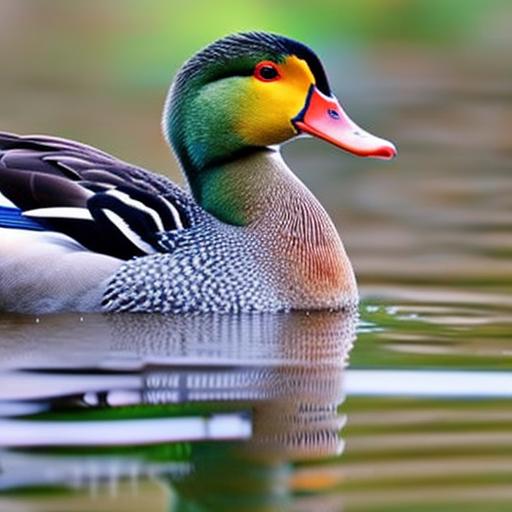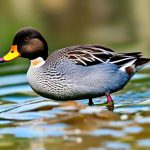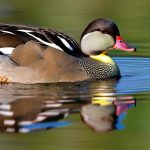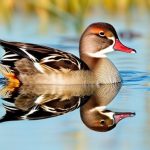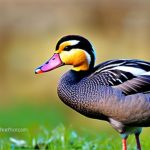Ducks are fascinating creatures that come in a wide variety of breeds, each with its own unique characteristics and traits. From domestic breeds that are popular choices for backyard flocks to ornamental breeds that are bred for their beauty, there is a duck breed to suit every preference. Understanding the different breeds is important for backyard flock owners as it allows them to choose the right ducks for their specific needs and provides insight into their care and management.
Key Takeaways
- Duck breeds come in a diverse range of sizes, colors, and personalities.
- Domestic duck breeds are popular choices for backyard flocks due to their ease of care and egg-laying abilities.
- Mallard duck breeds are the wild ancestors of domestic ducks and can still be found in the wild today.
- Ornamental duck breeds are bred for their beauty and are often shown in competitions.
- Pekin duck breeds are classic white ducks with big personalities and are commonly used for meat production.
Domestic Duck Breeds: Popular Choices for Backyard Flocks
One of the most popular domestic duck breeds is the Pekin duck. Known for its white feathers and orange bill, the Pekin duck is a large and friendly breed that is great for backyard flocks. They are excellent egg layers and can produce up to 200 eggs per year. Pekin ducks are also known for their calm and docile nature, making them easy to handle and care for.
Another popular domestic duck breed is the Khaki Campbell. This breed is highly regarded for its exceptional egg-laying abilities, with some Khaki Campbells producing up to 300 eggs per year. They have a slender body shape and a khaki-colored plumage, which gives them their name. Khaki Campbells are active ducks that enjoy foraging and exploring, making them a great choice for those with larger outdoor spaces.
Caring for domestic duck breeds involves providing them with a suitable living environment, including a secure coop or shelter, access to fresh water for swimming, and a balanced diet that includes a mix of commercial feed and fresh greens. Regular health checks and vaccinations are also important to ensure the well-being of the ducks.
Mallard Duck Breeds: The Wild Ancestry of Domestic Ducks
Domestic ducks have evolved from wild mallards through selective breeding over thousands of years. Mallard duck breeds, such as the Black and White Mallard, still retain many of the characteristics of their wild ancestors. These ducks have a beautiful plumage, with the males displaying vibrant colors and distinctive markings. Mallard duck breeds are known for their strong flying abilities and adaptability to various environments.
Preserving wild mallard populations is important for maintaining the genetic diversity of domestic duck breeds. Wild mallards play a crucial role in the ecosystem, as they help control insect populations and disperse seeds. Conservation efforts, such as habitat preservation and protection from hunting, are essential to ensure the survival of these magnificent birds.
Ornamental Duck Breeds: Beautiful Ducks for Show and Display
Ornamental duck breeds are bred for their beauty and are often showcased in exhibitions and shows. One such breed is the Mandarin duck, which is known for its vibrant plumage and striking patterns. Mandarin ducks are native to East Asia and have become popular around the world due to their stunning appearance.
Another ornamental duck breed is the Wood Duck, which is native to North America. Wood ducks have a unique combination of colors, with males sporting iridescent green and purple feathers on their heads and chests. They are highly sought after by birdwatchers and photographers due to their striking appearance.
Caring for ornamental duck breeds requires attention to detail, as their beautiful plumage can be delicate and prone to damage. Providing them with a clean and spacious enclosure that mimics their natural habitat is essential. Additionally, ornamental ducks may require special diets to maintain their vibrant colors.
Pekin Duck Breeds: The Classic White Duck with a Big Personality
Pekin ducks are one of the most recognizable duck breeds, thanks to their classic white feathers and bright orange bills. They are medium-sized ducks with a plump body shape and a friendly disposition. Pekin ducks are known for their big personalities and can be quite entertaining to watch.
One interesting fact about Pekin ducks is that they were originally bred in China and were brought to the United States in the 1870s. Since then, they have become one of the most popular duck breeds worldwide. Pekin ducks are excellent egg layers, with females capable of producing up to 200 eggs per year. They are also known for their fast growth rate, making them a popular choice for meat production.
Caring for Pekin ducks involves providing them with a suitable living environment that includes access to fresh water for swimming and bathing. Pekin ducks are voracious eaters and require a balanced diet that includes a mix of commercial feed and fresh greens. Regular health checks and vaccinations are also important to ensure their well-being.
Runner Duck Breeds: The Quirky Ducks with an Upright Posture

Runner ducks are a unique breed known for their upright posture and distinctive walking style. They have a slender body shape and long necks, which gives them an elegant appearance. Runner ducks are highly active and enjoy foraging and exploring their surroundings.
One interesting characteristic of Runner ducks is their ability to run in an upright position, which sets them apart from other duck breeds. This behavior is believed to have originated from their wild ancestors, who would run rather than fly when threatened. Runner ducks come in various colors, including white, black, and fawn.
Caring for Runner ducks involves providing them with a secure enclosure that allows them to exercise and explore. They require access to fresh water for swimming and bathing, as well as a balanced diet that includes a mix of commercial feed and fresh greens. Runner ducks are social animals and thrive in the company of other ducks, so it is recommended to keep them in pairs or small groups.
Muscovy Duck Breeds: The Unique Ducks with a Red Face and Caruncles
Muscovy ducks are a unique breed known for their distinctive appearance, which includes a red face and fleshy caruncles on their heads. They have a large body size and a calm and docile temperament. Muscovy ducks are native to Central and South America but have been domesticated and introduced to other parts of the world.
One interesting characteristic of Muscovy ducks is their ability to perch on trees, thanks to their strong claws. This behavior is believed to have evolved as a defense mechanism against predators. Muscovy ducks come in various colors, including black, white, and blue.
Caring for Muscovy ducks involves providing them with a suitable living environment that includes access to fresh water for swimming and bathing. They require a balanced diet that includes a mix of commercial feed and fresh greens. Muscovy ducks are excellent foragers and enjoy eating insects, snails, and other small creatures.
Rouen Duck Breeds: The Large, Majestic Ducks with a Green Sheen
Rouen ducks are a large and majestic breed known for their beautiful plumage, which includes shades of green, brown, and black. They have a plump body shape and a calm and friendly temperament. Rouen ducks are often mistaken for wild mallards due to their similar appearance.
One interesting fact about Rouen ducks is that they were originally bred in France as meat ducks. They were later imported to the United States in the 19th century and became popular for their size and meat quality. Rouen ducks are also known for their excellent egg-laying abilities, with females capable of producing up to 150 eggs per year.
Caring for Rouen ducks involves providing them with a suitable living environment that includes access to fresh water for swimming and bathing. They require a balanced diet that includes a mix of commercial feed and fresh greens. Rouen ducks are social animals and thrive in the company of other ducks, so it is recommended to keep them in pairs or small groups.
Khaki Campbell Duck Breeds: The Egg-Laying Machines of the Duck World
Khaki Campbell ducks are highly regarded for their exceptional egg-laying abilities, making them the “egg-laying machines” of the duck world. They have a slender body shape and a khaki-colored plumage, which gives them their name. Khaki Campbell ducks are active and enjoy foraging and exploring their surroundings.
One interesting fact about Khaki Campbell ducks is that they were originally bred in England by a man named Adele Campbell. He aimed to create a breed that would lay a high number of eggs while also being suitable for meat production. Khaki Campbell ducks can produce up to 300 eggs per year, making them one of the most productive duck breeds.
Caring for Khaki Campbell ducks involves providing them with a suitable living environment that includes access to fresh water for swimming and bathing. They require a balanced diet that includes a mix of commercial feed and fresh greens. Regular health checks and vaccinations are also important to ensure their well-being.
Welsh Harlequin Duck Breeds: The Colorful Ducks with a Calm Disposition
Welsh Harlequin ducks are a colorful breed known for their calm and docile disposition. They have a medium-sized body shape and a striking plumage, which includes shades of silver, white, and brown. Welsh Harlequin ducks are highly regarded for their beauty and are often kept as ornamental birds.
One interesting characteristic of Welsh Harlequin ducks is their ability to lay a high number of eggs while also being good mothers. They are excellent egg layers, with females capable of producing up to 250 eggs per year. Welsh Harlequin ducks are also known for their calm and friendly nature, making them easy to handle and care for.
Caring for Welsh Harlequin ducks involves providing them with a suitable living environment that includes access to fresh water for swimming and bathing. They require a balanced diet that includes a mix of commercial feed and fresh greens. Welsh Harlequin ducks are social animals and thrive in the company of other ducks, so it is recommended to keep them in pairs or small groups.
In conclusion, the world of duck breeds is diverse and fascinating, with each breed having its own unique characteristics and traits. From domestic breeds that are popular choices for backyard flocks to ornamental breeds that are bred for their beauty, there is a duck breed to suit every preference. Understanding the different breeds is important for backyard flock owners as it allows them to choose the right ducks for their specific needs and provides insight into their care and management. Whether you’re looking for a friendly and productive egg-layer or a beautiful show bird, exploring the world of duck breeds is sure to be an exciting and rewarding experience.
If you’re interested in learning more about different duck breeds and their characteristics, you might also enjoy reading our article on “Choosing the Right Duck Breed for Your Farm.” This comprehensive guide provides valuable insights into various duck breeds, including their size, temperament, egg-laying capabilities, and more. To make it even more informative, we’ve included beautiful pictures of each breed to help you visualize their unique features. So whether you’re a seasoned duck enthusiast or just starting out, this article will surely help you make an informed decision when selecting the perfect duck breed for your farm. Check it out here.
FAQs
What are the different breeds of ducks?
There are over 100 different breeds of ducks, including the popular Pekin, Muscovy, Mallard, and Rouen.
What is the difference between domestic and wild ducks?
Domestic ducks are bred for their meat, eggs, or ornamental purposes, while wild ducks are found in their natural habitats and are not typically kept as pets.
What are some characteristics of the Pekin duck?
The Pekin duck is a large, white, domesticated breed that is commonly used for meat production. They have a calm temperament and are known for their high egg-laying capabilities.
What is unique about the Muscovy duck?
The Muscovy duck is a domesticated breed that is native to South America. They have a distinctive red face and are known for their ability to control insect populations.
What is the difference between a male and female duck?
Male ducks, also known as drakes, are typically larger and have more colorful plumage than female ducks, also known as hens. Male ducks also have a curled feather on their tail, while females do not.
What is the lifespan of a duck?
The lifespan of a duck varies depending on the breed and living conditions, but on average, domestic ducks can live up to 10 years, while wild ducks typically live 2-3 years.
What is the purpose of keeping ducks?
Ducks can be kept for their meat, eggs, feathers, or as pets. They are also used for pest control in gardens and farms.
Meet Walter, the feathered-friend fanatic of Florida! Nestled in the sunshine state, Walter struts through life with his feathered companions, clucking his way to happiness. With a coop that’s fancier than a five-star hotel, he’s the Don Juan of the chicken world. When he’s not teaching his hens to do the cha-cha, you’ll find him in a heated debate with his prized rooster, Sir Clucks-a-Lot. Walter’s poultry passion is no yolk; he’s the sunny-side-up guy you never knew you needed in your flock of friends!

